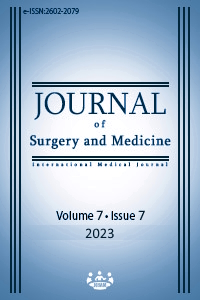Differentiation of glioblastoma, brain metastases and central nervous system lymphomas using amount of vasogenic edema and diffusion MR imaging of tumor core and peritumoral zone- Searching for a practical approach
Differential diagnosis of solitary malignant brain tumors with MRI findings
Keywords:
magnetic resonance imaging, brain edema, brain neoplasms, neuroimagingAbstract
Background/Aim: The differential diagnosis of solitary brain tumors poses challenges for clinicians and radiologists, often leading to invasive biopsy procedures. Therefore, this study aimed to evaluate the variations in edema volume and diffusion characteristics between the tumor core and peritumoral zone in cases of glioblastoma, brain metastasis, and central nervous system lymphoma. The aim was to identify additional parameters for conventional magnetic resonance imaging (MRI) that could aid in the differential diagnosis.
Methods: A total of 39 patients (13 with central nervous system lymphoma, 13 with glioblastoma, and 13 with brain metastases) were included in this retrospective cohort study. Apparent diffusion coefficient (ADC) values were calculated from the ADC maps obtained from Brain MRI for both the lesion and peritumoral region. Additionally, the largest diameter of the vasogenic edema-mass complex was measured using T2 sequences. In the contrast-enhanced series, the largest diameter of the metastatic lesion was measured. The edema-mass ratio was determined by dividing the diameter of the edema-mass complex by the diameter of the mass.
Results: There was a statistically significant difference in the edema-mass ratio among the tumor types (P=0.008). Further analysis using Bonferroni correction revealed that this difference was primarily due to glioblastoma. Compared to patients with lymphoma and brain metastases, lesions diagnosed as glioblastoma exhibited a lower edema-mass ratio. Additionally, a statistically significant difference was observed in the ADC value measured from the lesion according to the tumor type (P=0.017). It was determined that lesions associated with central nervous system lymphoma had lower ADC values than those with glioblastoma.
Conclusion: Including lesional and perilesional ADC values obtained through diffusion-weighted examination and edema mass ratio measurements may enhance the accuracy of differential diagnosis. Utilizing these imaging characteristics in a multiparametric approach, as suggested by this research, can improve the accuracy of diagnosing malignant cancers, thereby enabling better patient management and treatment decisions.
Downloads
References
Omuro A, De Angelis LM. Glioblastoma and other malignant gliomas: a clinical review. JAMA. 2013;310(17):1842-50. DOI: https://doi.org/10.1001/jama.2013.280319
Sperduto PW, Chao ST, Sneed PK, Luo X, Suh J, Roberge D, et al. Diagnosis-specific prognostic factors, indexes, and treatment outcomes for patients with newly diagnosed brain metastases: a multi-institutional analysis of 4,259 patients. Int J Radiat Oncol Biol Phys. 2010 Jul 1;77(3):655-61. doi: 10.1016/j.ijrobp.2009.08.025. Epub 2009 Nov 26. PMID: 19942357. DOI: https://doi.org/10.1016/j.ijrobp.2009.08.025
Pasricha S, Gupta A, Gawande J, Trivedi P, Patel D. Primary central nervous system lymphoma: a study of clinicopathological features and trend in western India. Indian J Cancer. 2011;48(2):199-203. DOI: https://doi.org/10.4103/0019-509X.82890
Haldorsen IS, Espeland A, Larsson EM. Central nervous system lymphoma: characteristic findings on traditional and advanced imaging. AJNR. 2011;32(6):984–92. DOI: https://doi.org/10.3174/ajnr.A2171
Peters S, Knöß N, Wodarg F, CnyrimC, Jansen O. Glioblastomas vs. lymphomas: More diagnostic certainty by using susceptibility-weighted imaging (SWI). Rofo. 2012;184(8):713–8. DOI: https://doi.org/10.1055/s-0032-1312862
Doskaliyev A, Yamasaki F, Ohtaki M, Kajiwara Y, Takeshima Y, Watanabe Y, et al. Lymphomas and glioblastomas: differences in the apparent diffusion coefficient evaluated with high b-value diffusion-weighted magnetic resonance imaging at 3T. Eur J Radiol. 2012 Feb;81(2):339-44. doi: 10.1016/j.ejrad.2010.11.005. Epub 2010 Dec 3. PMID: 21129872. DOI: https://doi.org/10.1016/j.ejrad.2010.11.005
Toh CH, Wei KC, Chang CN, Ng SH, Wong HF. Differentiation of primary central nervous system lymphomas and glioblastomas: comparisons of diagnostic performance of dynamic susceptibility contrast enhanced perfusion MR imaging without and with contrast-leakage correction. AJNR 2013;34(6):1145–9. DOI: https://doi.org/10.3174/ajnr.A3383
Wang S, Kim S, Chawla S, Wolf RL, Knipp DE, Vossough A, et al. Differentiation between glioblastomas, solitary brain metastases, and primary cerebral lymphomas using diffusion tensor and dynamic susceptibility contrast-enhanced MR imaging. AJNR Am J Neuroradiol. 2011 Mar;32(3):507-14. doi: 10.3174/ajnr.A2333. Epub 2011 Feb 17. PMID: 21330399; PMCID: PMC8013110. DOI: https://doi.org/10.3174/ajnr.A2333
Kono K, Inoue Y, Nakayama K, Shakudo M, Morino M, Ohata K, et al. The role of diffusion-weighted imaging in patients with brain tumors. AJNR Am J Neuroradiol. 2001 Jun-Jul;22(6):1081-8. PMID: 11415902; PMCID: PMC7974804.
Krabbe K, Gideon P, Wagn P, Hansen U, Thomsen C, Madsen F. MR diffusion imaging of human intracranial tumours. Neuroradiology. 1997;39(7):483-9. DOI: https://doi.org/10.1007/s002340050450
Stummer, W. Mechanisms of tumor-related brain edema, Neurosurgical Focus. 2007;22(5): 1-7. DOI: https://doi.org/10.3171/foc.2007.22.5.9
Calli C, Kitis O, Yunten N, Yurtseven T, Islekel S, Akalin T. Perfusion and diffusion MR imaging in enhancing malignant cerebral tumors. Eur J Radiol. 2006;58(3):394-403. DOI: https://doi.org/10.1016/j.ejrad.2005.12.032
Chiang IC, Kuo YT, Lu CY, Yeung KW, Lin WC, Sheu FO, et al. Distinction between high-grade gliomas and solitary metastases using peritumoral 3-T magnetic resonance spectroscopy, diffusion, and perfusion imagings. Neuroradiology. 2004 Aug;46(8):619-27. doi: 10.1007/s00234-004-1246-7. Epub 2004 Jul 9. PMID: 15243726. DOI: https://doi.org/10.1007/s00234-004-1246-7
Jain RK, diTomaso E, Duda DG, Loeffler JS, Sorensen AG, Batchelor TT. Angiogenesis in brain tumours. Nat Rev Neurosci. 2007;8(8):610-22. DOI: https://doi.org/10.1038/nrn2175
Lemercier P, Paz Maya S, Patrie JT, Flors L, Leiva-Salinas C. Gradient of apparent diffusion coefficient values in peritumoral edema helps in differentiation of glioblastoma from solitary metastatic lesions. AJR. 2014;203(1):163-9. DOI: https://doi.org/10.2214/AJR.13.11186
Pavlisa G, Rados M, Pavlisa G, Pavic L, Potocki K, Mayer D. The differences of water diffusion between brain tissue infiltrated by tumor and peritumoral vasogenic edema. Clin Imaging. 2009;33(2):96-101. DOI: https://doi.org/10.1016/j.clinimag.2008.06.035
Lee EJ, terBrugge K, Mikulis D, Choi DS, Bae JM, Lee SK, et al. Diagnostic value of peritumoral minimum apparent diffusion coefficient for differentiation of glioblastoma multiforme from solitary metastatic lesions. AJR Am J Roentgenol. 2011 Jan;196(1):71-6. doi: 10.2214/AJR.10.4752. PMID: 21178049. DOI: https://doi.org/10.2214/AJR.10.4752
Downloads
- 858 634
Published
Issue
Section
How to Cite
License
Copyright (c) 2023 Ezel Yaltırık Bilgin, Özkan Ünal
This work is licensed under a Creative Commons Attribution-NonCommercial-NoDerivatives 4.0 International License.
















